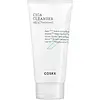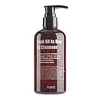What's inside
What's inside
 Key Ingredients
Key Ingredients

 Benefits
Benefits

 Concerns
Concerns

 Ingredients Side-by-side
Ingredients Side-by-side

Water
Skin ConditioningSodium Cocoyl Isethionate
CleansingGlycerin
HumectantGlyceryl Stearate
EmollientStearyl Alcohol
EmollientCoco-Betaine
CleansingSodium Methyl Cocoyl Taurate
CleansingSodium Chloride
MaskingCoco-Glucoside
CleansingCaprylyl Glycol
EmollientGlyceryl Caprylate
EmollientCitric Acid
BufferingEucalyptus Globulus Leaf Oil
PerfumingDisodium EDTA
Ocimum Basilicum Oil
Masking1,2-Hexanediol
Skin ConditioningQuillaja Saponaria Bark Extract
CleansingPropanediol
SolventCentella Asiatica Extract
CleansingCentella Asiatica Leaf Extract
Skin ConditioningCentella Asiatica Root Extract
Skin ConditioningSaccharomyces Ferment
Skin ConditioningEthylhexylglycerin
Skin ConditioningAsiatic Acid
Skin ConditioningAsiaticoside
AntioxidantMadecassic Acid
Skin ConditioningMadecassoside
AntioxidantPinus Pinaster Bark Extract
AntioxidantWater, Sodium Cocoyl Isethionate, Glycerin, Glyceryl Stearate, Stearyl Alcohol, Coco-Betaine, Sodium Methyl Cocoyl Taurate, Sodium Chloride, Coco-Glucoside, Caprylyl Glycol, Glyceryl Caprylate, Citric Acid, Eucalyptus Globulus Leaf Oil, Disodium EDTA, Ocimum Basilicum Oil, 1,2-Hexanediol, Quillaja Saponaria Bark Extract, Propanediol, Centella Asiatica Extract, Centella Asiatica Leaf Extract, Centella Asiatica Root Extract, Saccharomyces Ferment, Ethylhexylglycerin, Asiatic Acid, Asiaticoside, Madecassic Acid, Madecassoside, Pinus Pinaster Bark Extract
Water
Skin ConditioningLauramide DEA
Sodium Laureth Sulfate
CleansingTea-Lauryl Sulfate
CleansingSnail Secretion Filtrate
Skin ConditioningSodium Lauryl Sulfate
CleansingPEG-7 Glyceryl Cocoate
EmulsifyingCocamidopropyl Betaine
CleansingPotassium Cocoyl Glycinate
Sodium Cocoyl Isethionate
CleansingDipropylene Glycol
HumectantChlorphenesin
AntimicrobialCitric Acid
BufferingBetaine
HumectantPanthenol
Skin ConditioningTocopheryl Acetate
AntioxidantCamellia Sinensis Leaf Extract
AntimicrobialGinkgo Biloba Leaf Extract
Skin ConditioningCentella Asiatica Extract
CleansingDisodium EDTA
Lavandula Angustifolia Flower Extract
CleansingViola Tricolor Extract
EmollientCentaurea Cyanus Flower Extract
AstringentButylene Glycol
HumectantPentylene Glycol
Skin ConditioningMethylisothiazolinone
Preservative1,2-Hexanediol
Skin ConditioningCaprylyl Glycol
EmollientParfum
MaskingWater, Lauramide DEA, Sodium Laureth Sulfate, Tea-Lauryl Sulfate, Snail Secretion Filtrate, Sodium Lauryl Sulfate, PEG-7 Glyceryl Cocoate, Cocamidopropyl Betaine, Potassium Cocoyl Glycinate, Sodium Cocoyl Isethionate, Dipropylene Glycol, Chlorphenesin, Citric Acid, Betaine, Panthenol, Tocopheryl Acetate, Camellia Sinensis Leaf Extract, Ginkgo Biloba Leaf Extract, Centella Asiatica Extract, Disodium EDTA, Lavandula Angustifolia Flower Extract, Viola Tricolor Extract, Centaurea Cyanus Flower Extract, Butylene Glycol, Pentylene Glycol, Methylisothiazolinone, 1,2-Hexanediol, Caprylyl Glycol, Parfum
Ingredients Explained
These ingredients are found in both products.
Ingredients higher up in an ingredient list are typically present in a larger amount.
1,2-Hexanediol is a synthetic liquid and another multi-functional powerhouse.
It is a:
- Humectant, drawing moisture into the skin
- Emollient, helping to soften skin
- Solvent, dispersing and stabilizing formulas
- Preservative booster, enhancing the antimicrobial activity of other preservatives
Caprylyl Glycol is a humectant and emollient, meaning it attracts and preserves moisture.
It is a common ingredient in many products, especially those designed to hydrate skin. The primary benefits are retaining moisture, skin softening, and promoting a healthy skin barrier.
Though Caprylyl Glycol is an alcohol derived from fatty acids, it is not the kind that can dry out skin.
This ingredient is also used as a preservative to extend the life of products. It has slight antimicrobial properties.
Learn more about Caprylyl GlycolCentella Asiatica Extract (Centella) is derived from an herb native to Southeast Asia. It is famous for its anti-inflammatory and soothing properties.
Centella is rich in antioxidants and amino acids, such as Madecassic Acid and Asiaticoside.
Studies show the compounds in centella help with:
The combination of all these properties makes centella effective at soothing, hydrating, and protecting the skin.
Other great components of centella include Vitamin A, vitamin C, several B vitamins, and Asiatic Acid.
Fun fact: Centella has been used as a medicine and in food for many centuries. As a medicine, it is used to treat burns, scratches, and wounds.
Learn more about Centella Asiatica ExtractCitric Acid is an alpha hydroxy acid (AHA) naturally found in citrus fruits like oranges, lemons, and limes.
Like other AHAs, citric acid can exfoliate skin by breaking down the bonds that hold dead skin cells together. This helps reveal smoother and brighter skin underneath.
However, this exfoliating effect only happens at high concentrations (20%) which can be hard to find in cosmetic products.
Due to this, citric acid is usually included in small amounts as a pH adjuster. This helps keep products slightly more acidic and compatible with skin's natural pH.
In skincare formulas, citric acid can:
While it can provide some skin benefits, research shows lactic acid and glycolic acid are generally more effective and less irritating exfoliants.
Most citric acid used in skincare today is made by fermenting sugars (usually from molasses). This synthetic version is identical to the natural citrus form but easier to stabilize and use in formulations.
Read more about some other popular AHA's here:
Learn more about Citric AcidDisodium EDTA plays a role in making products more stable by aiding other preservatives.
It is a chelating agent, meaning it neutralizes metal ions that may be found in a product.
Disodium EDTA is a salt of edetic acid and is found to be safe in cosmetic ingredients.
Learn more about Disodium EDTASodium cocoyl isethionate is a natural ingredient from coconut oil. It is an ultra gentle cleanser that gives a nice foam without drying the skin or impacting the skin barrier.
The amount of foam created depends on the amount of sodium cocoyl isethionate used in the product.
This ingredient also helps improve the spreadability of a product.
Learn more about Sodium Cocoyl IsethionateWater. It's the most common cosmetic ingredient of all. You'll usually see it at the top of ingredient lists, meaning that it makes up the largest part of the product.
So why is it so popular? Water most often acts as a solvent - this means that it helps dissolve other ingredients into the formulation.
You'll also recognize water as that liquid we all need to stay alive. If you see this, drink a glass of water. Stay hydrated!
Learn more about Water